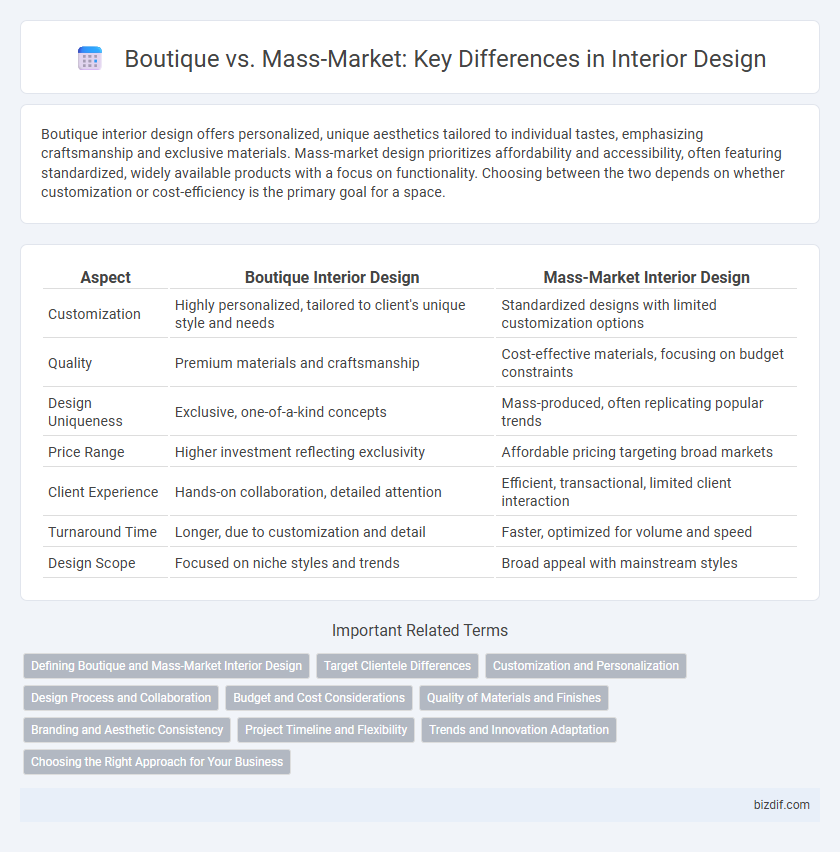Boutique interior design offers personalized, unique aesthetics tailored to individual tastes, emphasizing craftsmanship and exclusive materials. Mass-market design prioritizes affordability and accessibility, often featuring standardized, widely available products with a focus on functionality. Choosing between the two depends on whether customization or cost-efficiency is the primary goal for a space.
Table of Comparison
| Aspect | Boutique Interior Design | Mass-Market Interior Design |
|---|---|---|
| Customization | Highly personalized, tailored to client's unique style and needs | Standardized designs with limited customization options |
| Quality | Premium materials and craftsmanship | Cost-effective materials, focusing on budget constraints |
| Design Uniqueness | Exclusive, one-of-a-kind concepts | Mass-produced, often replicating popular trends |
| Price Range | Higher investment reflecting exclusivity | Affordable pricing targeting broad markets |
| Client Experience | Hands-on collaboration, detailed attention | Efficient, transactional, limited client interaction |
| Turnaround Time | Longer, due to customization and detail | Faster, optimized for volume and speed |
| Design Scope | Focused on niche styles and trends | Broad appeal with mainstream styles |
Defining Boutique and Mass-Market Interior Design
Boutique interior design centers on personalized, unique spaces crafted with high-quality materials, tailored to individual tastes and often featuring custom furnishings and artisanal details. Mass-market interior design emphasizes affordability and accessibility, utilizing standardized products and trends to decorate large-volume spaces quickly and efficiently. The distinction lies in the exclusivity and craftsmanship of boutique design versus the scalability and cost-effectiveness of mass-market solutions.
Target Clientele Differences
Boutique interior design firms specialize in personalized, high-end projects tailored to discerning clients seeking unique, custom aesthetics that reflect individual lifestyle and taste. Mass-market design services cater to a broader audience prioritizing affordability, functionality, and trends that appeal to mainstream preferences within larger housing developments or commercial spaces. Target clientele for boutique services typically include luxury homeowners and niche commercial clients, while mass-market designs attract middle-income families and developers focused on volume and cost efficiency.
Customization and Personalization
Boutique interior design offers unparalleled customization and personalization, tailoring every detail to reflect the unique tastes and lifestyles of individual clients. Mass-market interior design prioritizes efficiency and broad appeal, featuring standardized options that limit customization but reduce costs. The choice between boutique and mass-market design hinges on the desire for exclusive, bespoke environments versus accessible, scalable solutions.
Design Process and Collaboration
Boutique interior design firms emphasize personalized design processes, collaborating closely with clients and artisans to create unique, bespoke spaces that reflect individual tastes and lifestyles. Mass-market design approaches rely on standardized, scalable solutions, often limiting customization and involving less direct collaboration with clients. This contrast impacts the depth of creative input and the level of detail tailored to the end user's preferences.
Budget and Cost Considerations
Boutique interior design services often involve higher upfront costs due to customized materials and personalized attention, appealing to clients with flexible budgets focused on unique aesthetics. Mass-market design solutions prioritize cost-efficiency by utilizing standardized products and streamlined processes, making them suitable for projects with strict budget constraints. Understanding budget allocation between bespoke creativity and economy-driven choices is crucial for optimizing design outcomes within financial limits.
Quality of Materials and Finishes
Boutique interior design prioritizes high-quality materials and finishes, often sourcing artisanal or custom elements that ensure durability and uniqueness. Mass-market interiors typically use cost-effective materials that may sacrifice longevity and distinctive craftsmanship for affordability. The selection of premium finishes in boutique designs enhances both aesthetic appeal and functional performance, setting them apart from standardized mass-market options.
Branding and Aesthetic Consistency
Boutique interior design firms emphasize unique branding and aesthetic consistency by tailoring each project to reflect the client's distinct personality and lifestyle, creating bespoke environments that stand out in the market. Mass-market design approaches prioritize scalability and trend-driven aesthetics, often resulting in more generic, widely appealing interiors with standardized branding elements. Maintaining aesthetic consistency in boutique design enhances brand identity and customer loyalty, whereas mass-market designs focus on efficiency and broad demographic appeal.
Project Timeline and Flexibility
Boutique interior design projects typically offer shorter timelines with greater flexibility due to personalized attention and customized solutions tailored to client preferences. Mass-market interior design often involves standardized processes that extend project duration and limit adaptability to specific client needs. Efficient communication and decision-making in boutique settings accelerate modifications, whereas mass-market approaches prioritize scalability over individualized flexibility.
Trends and Innovation Adaptation
Boutique interior design firms excel in rapid adaptation to emerging trends and innovative materials, offering highly personalized and cutting-edge solutions that cater to niche markets and discerning clients. Mass-market designers prioritize scalable, cost-effective trends, often relying on proven, mainstream styles and technologies to appeal to a broad audience and maintain affordability. The balance between exclusivity and accessibility defines the innovation trajectory in both sectors, with boutiques pushing boundaries through bespoke creativity while mass-market emphasizes trend longevity and mass adoption.
Choosing the Right Approach for Your Business
Boutique interior design firms emphasize personalized, high-end services tailored to unique client needs, fostering exclusivity and creativity in every project. Mass-market design companies prioritize scalability and affordability, leveraging standardized solutions to serve a broader customer base efficiently. Selecting the right approach depends on your business goals, target market, and capacity to deliver either customized luxury or cost-effective volume services.
Boutique vs Mass-market Infographic

 bizdif.com
bizdif.com